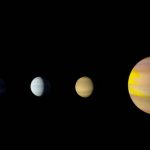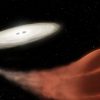Astronomers find first compelling evidence for a moon outside our solar system0
- From Around the Web
- October 5, 2018
New Neptune-sized exomoon candidate has been observed around a star some 8,000 light years away

New Neptune-sized exomoon candidate has been observed around a star some 8,000 light years away

Life needs a stable climate.

NASA’s Kepler Space Telescope has caught a kind of stellar explosion called a Fast-Evolving Luminous Transient (FELT) in the act.

Trailing Earth’s orbit at 94 million miles away, the Kepler space telescope has survived many potential knock-outs during its nine years in flight, from mechanical failures to being blasted by cosmic rays. At this rate, the hardy spacecraft may reach its finish line in a manner we will consider a wonderful success. With nary a gas station to be found in deep space, the spacecraft is going to run out of fuel. We expect to reach that moment within several months.

Astronomers using data from NASA’s extended Kepler mission, known as K2, have discovered 95 new exoplanets, with sizes ranging from mostly rocky super-Earths and fluffy mini-Neptunes to Jupiter-like gaseous giants.

In NASA’s efforts to explore the endless expanse of space, the agency eventually came to a realization: there is simply too much data. Missions like the one embarked upon in 2009 by the Kepler space telescope yield such a tremendous amount of data that there’s no efficient way for an individual scientist or even a team of scientists at NASA to pour through it all. That’s when they made a realization — instead of handling everything internally, NASA could make this data publicly available so that citizen scientists all over the world would be able to dig in.

Our solar system now is tied for most number of planets around a single star, with the recent discovery of an eighth planet circling Kepler-90, a Sun-like star 2,545 light-years from Earth. The planet was discovered in data from NASA’s Kepler Space Telescope.

Nasa has found an entire solar system with as many planets as our own.

Scientists from MIT and other institutions, working closely with amateur astronomers, have spotted the dusty tails of six exocomets — comets outside our solar system — orbiting a faint star 800 light years from Earth.

If confirmed, the shiny new worlds may help astronomers better understand how strange planets known as hot Jupiters are created.



